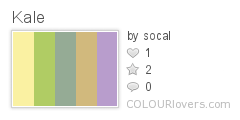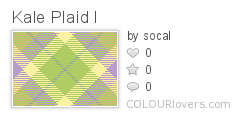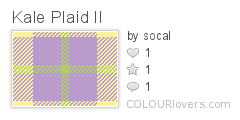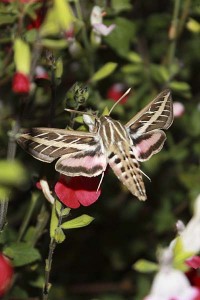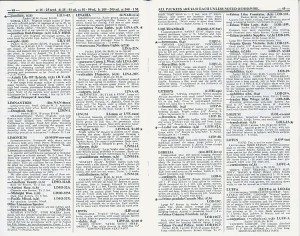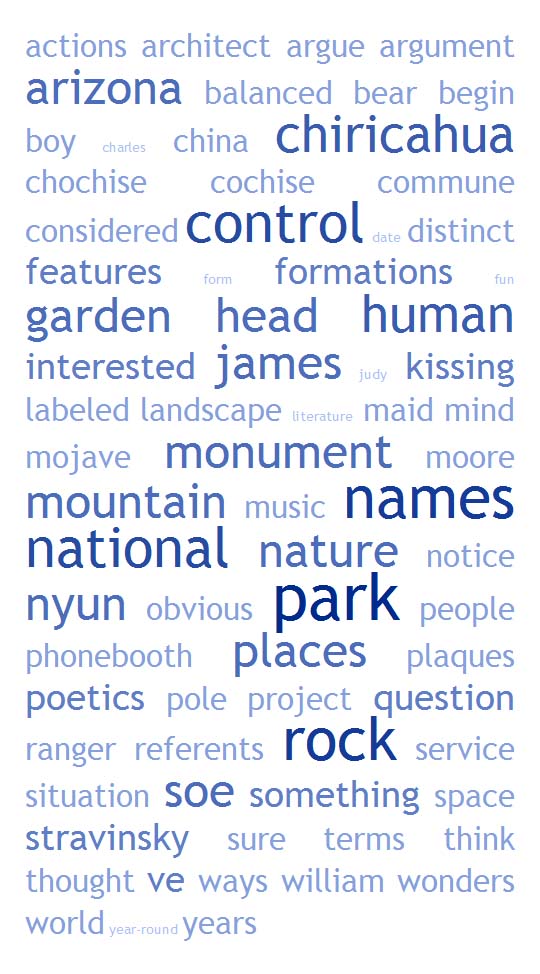I was out picking kale. In one pile I had the leaves for dinner, in the other the older leaves that were going to get recycled. Pretty interesting colors to the leaves, I was thinking… (Color toys below from Colourlovers.)
Category Archives: rambles
sphinx moths
Along with the flowers, spring brings its share of insects. I could do without the ants that are now beginning to explore the interior of the house, but the sphinx moths that started to appear in huge numbers last week are about as cool as any bug out there.
This is the white-lined sphinx moth, Hyles lineata. Although its main range is the American West and northern Mexico, the species can be found all over the US. (Check out the writeup at the terrific Butteryflies and Moths of North America site for more information.)
There are dozens of other sphinx moths, including the adults of the notorious tomato and tobacco hornworms, familiar to almost anyone who’s tried to grow a tomato plant. The caterpillars of the white-lined sphinxes, however, don’t seem to have the reputation for going on the same sort of sustained rampages against our vegetable gardens.
The way these large, muscular insects maneuver and hover over flowers as they feed reminds you of hummingbirds, and in fact they’re also called “hummingbird moths.” As with hummingbirds, they enjoy nectar-rich flowers, such as this Hot Lips sage. You can see these moths feeding during the daylight, but the populations really come out after the sun sets, forming quietly buzzing clouds at dusk or before the sun rises.
In no way do I consider myself an insect photographer. I quickly found out how frustrating it can be to photograph fast-moving moths with a camera that refuses to focus in the dark. These are the only two photos I kept out of a couple dozen tries.
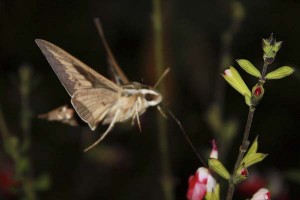 This second image is no stunner, but you can begin to make out the amazing long tongue that the moth uses to lap up the tasty nectar.
This second image is no stunner, but you can begin to make out the amazing long tongue that the moth uses to lap up the tasty nectar.
If you’re into insect photos done as well as anyone out there can do them, you should take a look at the work of Bob Parks. He was working at San Diego’s Museum of Natural History when I first met him ten or so years ago. I don’t know of anyone as passionate and devoted to bugs and photos of bugs. That passion shows in his technically outstanding and patiently rendered pictures. There’s a nice biographical writeup of him at the SDNHM site.
anagrams for darwin day
The bicentennial of the birth of Charles Darwin (on February 12, 1809) is approaching. How many other people have contributed more to our understanding of natural history? I say, it’s something to celebrate!
Here are some botanical-themed anagrams using the letters of his name. They were generated using the Internet Anagram Server, a totally magnificent way to waste spend your waking hours. (With 7974 anagrams to choose from I’ve probably missed a few other choice ones.)
The first one is so concise and poetic it makes haiku look verbose.
Larch rains dew
Larch aids wren
Earl wins chard
Lawn ires chard
Car: “I shred lawn”
…and last but not least:
Red lawn chairs
[ Image to the right from the Cedar Chair Store website ]
treefall
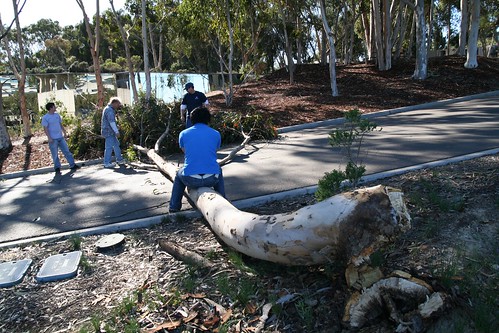 I was heading back to my desk at work on Thursday and noticed a cluster of my coworkers looking out a window. There’s a little access road right outside. Usually it doesn’t have a full-grown eucalyptus tree fallen across it, but this day it did.
I was heading back to my desk at work on Thursday and noticed a cluster of my coworkers looking out a window. There’s a little access road right outside. Usually it doesn’t have a full-grown eucalyptus tree fallen across it, but this day it did.
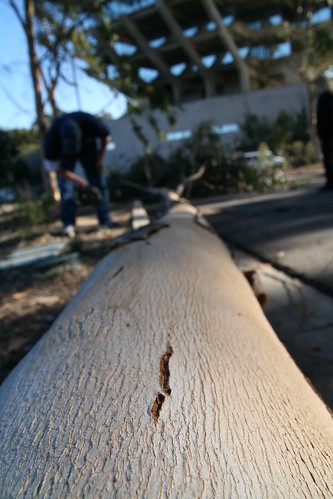 I don’t have my camera with me most of the time, but Declan had his. He was part of the volunteer crew who wrestled the tree to the curb, but he also managed take these shots.
I don’t have my camera with me most of the time, but Declan had his. He was part of the volunteer crew who wrestled the tree to the curb, but he also managed take these shots.
[ View the entire set on Flikr ]
Not much later the building’s safety person had issued a warning:
Just a heads-up, literally: high winds are blowing down eucalyptus branches and trees around campus. About an hour ago, an entire tree broke off and fell across the access road… (Very fortunately, no people or vehicles were in its path.) Until the winds die down, please be sure to watch and listen for breaking branches and avoid walking through the eucalyptus groves.
The UCSD campus is home to over 200 thousand of these trees in plantings that date back a hundred years, back to a eucalyptus mania when eucalyptus were planted all over Southern California, including three million just a few miles up the coast in what’s now Rancho Santa Fe.
If you live in this part of the state you’ve probably heard the stories: that the trees are call widowmakers because they drop their branches if you look at them wrong, that they’re just giant non-native weeds that take up valuable space…bad things like that.
I wonder if the bad rap on the first count is entirely deserved. For sure, some eucalyptus are brittle, and there have been three times in the last year alone when I was within fifty feet or thirty seconds of being taken out by falling eucalyptus. But with almost a quarter million of them on campus and millions of them in town it’s inevitable that a few of them keel over or fall apart. Are they that much worse than oaks or other trees that people plant by the millions?
I did a quick and totally informal survey of some headlines, eucalyptus versus oaks. Maybe the eucs are totally bad news. May they’re not that much worse than other species. Whatever the case, they definitely can be gorgeous trees.
Shadows cast over towering eucalyptuses (Eucalypturs kills woman in Old Town San Diego, The San Diego Union-Tribune–January 8, 2003)
2 killed in ‘freak accident’ : Falling oak crushes pickup on County Line Rd. (Oak tree, The Post and Courier (Charleston, N.C.)–April 16, 2008)
Tree check asked after accident (Eucalyptus kills woman in parked pickup truck, Evening Tribune (San Diego, CA)–December 25, 1987)
Man killed by falling tree (Oak tree falls onto pickup truck, News Sentinel, (Knoxville, TN) December 28, 2008)
$160,000 awarded in Zoo death (Award given to family of girl killed by falling eucalyptus, The San Diego Union–August 2, 1986)
Girl killed by falling tree at Boy Scout camp (Oak tree, Associated Press, via MSNBC–August 10, 2005)
Half of the incidents above involved pickup trucks. Weird. Maybe that’s the deadly combination: pickup trucks and large trees. Like mobile homes and tornadoes…
fun with beets
I don’t usually post a pile of recipes here, but Friday night I was faced with a nice bunch of golden beets that needed to be used. I made a loaf with the beet greens and then grated and sauteed the beets with a parsnip.
The mother recipes I began with were out of Jeannette Ferrary’s and Louise Fiszer’s The California-American Cookbook: Innovations on American Regional Dishes. But since I was missing some ingredients and had some others on hand, the final preparations ended pretty different from the originals. Both seemed like good ways to honor ingredients that are now in season.
John usually only grudgingly accepts beets at the table. However, he thought both of these were keepers, so I thought I’d better write them down before I forget what I did.
If this were a proper food blog, I’d have waylaid the plates on the way to the table before serving them. But the food was long gone before I had a chance to think of that. Maybe I should have posted photos of the dirty dishes after all the beet concoctions had been devoured…
Loaf of Beet Greens
- Olive oil
- Beet greens, tops of 1 large bunch (ca. 3 large beets), including stems, chopped
- 1 clove garlic, minced
- 1 medium onion, chopped fine
- 1 serrano chili, seeded, membranes removed, slivered
- 3 eggs
- 1/2 cup shredded cheese (I used Trader Joes’ Quattro Formaggi)
- 1/4 pound good firm tofu, cut in 3/8 inch cubes
- salt
- pepper
- small sprinkling of nutmeg
Preheat oven to 350. Saute beets, onion, garlic and chili in oil until wilted, ca. 5-8 minutes. Salt and pepper to taste. Remove from heat.
Mix eggs, cheese, tofu and nutmeg in bowl, and then stir into beet green mixture.
Pour into greased loaf pan and bake 25 minutes. Allow to set 10 minutes before serving.
Serves 4
Root Vegetables in Tequila Lime Butter
- 3 tablespoons butter
- 3 large beets, golden beets preferred, ends removed, peeled and grated
- 1 medium parsnip, peeled and grated
- zest of 1 lime
- juice of 1/2 lime
- 1 tablespoon sugar
- 1 1/2 tablespoons tequila
- salt
- pepper
- 2 tablespoons minced cilantro to garnish (optional)
In a bowl mix together lime juice, zest and sugar. In a saucepan saute beets in melted butter over high heat for 3 minutes. Add salt and pepper. Add tequila, and then lime mixture, and cook for 3 more minutes. Serve garnished with cilantro.
Serves 3-4
blog typography
In response to my post on the interesting typography of the J.L. Hudson seed catalog, Philip wondered whether it would be possible to design a blog so that it would look like an older publication that was typeset without the aid of computers.
There are lots of blog design elements, but one of the most important is the main text that people read. Here are a couple attempts at coming up with an online typographic style that looks a little more oldschool, more pre-computer.
Lorem ipsum dolor sit amet, consectetur adipisicing elit, sed do eiusmod tempor incididunt ut labore et dolore magna aliqua. Ut enim ad minim veniam, quis nostrud exercitation ullamco laboris nisi ut aliquip ex ea commodo consequat. Duis aute irure dolor in reprehenderit in voluptate velit esse cillum dolore eu fugiat nulla pariatur. Excepteur sint occaecat cupidatat non proident, sunt in culpa qui officia deserunt mollit anim id est laborum.
Lorem ipsum dolor sit amet, consectetur adipisicing elit, sed do eiusmod tempor incididunt ut labore et dolore magna aliqua. Ut enim ad minim veniam, quis nostrud exercitation ullamco laboris nisi ut aliquip ex ea commodo consequat. Duis aute irure dolor in reprehenderit in voluptate velit esse cillum dolore eu fugiat nulla pariatur. Excepteur sint occaecat cupidatat non proident, sunt in culpa qui officia deserunt mollit anim id est laborum.
So do they look on the right track?
This is a greatly condensed version of a much more technical post. Click “continue reading” below to see the full version.
Continue reading blog typography
mostly words
My winter pile of plant and seed catalogs contains one that doesn’t fit the usual model. Instead of page after page of gorgeous soft-core pornographic photos and drawings of plants in brawny full leaf and buxom full bloom, the J.L. Hudson Seedsman catalog takes the form of a tight 95 pages of black-on-white text and only twenty-five small line drawings for illustrations.
This is a catalog all about words. It could well change your expectations of what a seed catalog should be. It’s listed as an “ethnobotanical catalog of seeds,” and you can sit down with it and read it like a novel. Most of the seeds descriptions come with a sentence or two of cultural trivia about the plant, mostly about how one of the world’s societies uses that plant. I’ve been finding that this is the catalog that I’ve been spending the most time with this year.
In addition to the interesting catalog copy, you start to notice that the text itself is gorgeous in the way it sits on the page. I was trying to place the special quality it has when I finally noticed on the last page an interesting statement: “This publication was typeset entirely without the use of computers.”
No computers? In 2009? So retro it’s avant-garde, like albums released on vinyl. But worry not. They also have an online presence.
This is definitely a catalog with attitude. It’s also a catalog with a purpose, a purpose that’s well documented in a statement on their website, a purpose that’s in line with their self-description as a “public access seed bank.” You can also start to understand the purpose when you look at the titles of the brief selection of books offered in the back of the catalog.
One of the works, Invasion Biology: Critique of a Pseudoscience, has a writeup that includes the statement, “We have all heard the breathless tales of the dangers of ‘invasive alien species,’ but what does science say about them? …In all cases… introduced species have increased biological diversity.”
Another title, Ecofascism: Lessons from the German Experience, gets a long writeup that includes the impassioned lines, “Most U.S. environmentalists are completely opposed to the aims of fascism, but reactionary forces have begun to bend ecological themes towards these very ends. Only through knowledge may we prevent this perversion of environmentalism.”
Once you understand where the catalog is coming from, you’ll start to understand the almost willful attitude that would drive them to offer seed of black mustard, one of the plants that has taken over much of the local ecosystem and has few friends among the plant people I know. And one of the recent online catalog supplements had seed for Arundo donax, a plant that has taken over some important local riparian habitats. Why don’t you just dump plutonium in your garden? Hmmmm…Does that make me an ecofascist?
You don’t have to agree with everything you see in the catalog, and you don’t have to buy anything out of it. But this is one publication that’s a must read if you’d like to get yourself thinking instead of all hot and bothered over the usual pretty pictures!
visualize your blog content
A lot of blogs these days–including this one–have tag clouds in their sidebars. These highly visual displays of tags the blogger has supplied give you a good sense of the kinds of topics the blog covers. And they give you a sense of how often the topics get discussed.
These do a nice job of displaying the words the blogger thought would be important, but they sometimes miss the big picture that you could get by turning an entire post into a cloud, something using all the words in the post, not just the ones supplied by the blogger.
One of the interesting things I saw in the coverage of Barack Obama’s inauguration was an Associated Press visualization of his inaugural address using an online tool to analyze the frequency of the words he used. (Perhaps the AP’s analysis was based on one at Free Government Information.) Then the story went on to compare it with a visualized version of George Bush’s 2005 inaugural address.
I used the same tool, TagCrowd, to re-visualize the same Obama speech. TagCrowd picks the most frequently used words and assigns different sizes to them. As in a regular tag cloud, the bigger the visualized word, the more times it was used.
But instead of comparing it to Bush’s address, I visualized Lincoln’s Gettysburg address, since people seem to compare Obama and Lincoln. You can see how language has shifted over one and a half centuries, as well as how differently the men use words.
Interesting, huh?
Then I thought, why not try visualizing some blog posts by turning all the words in blog posts into clouds? Would the results between posts be that different? And would they differ much from the tag cloud in my left sidebar?
The first posting I analyzed is a recent one, “greener gardening practices,” from January 7:
How would that gardening post compare with one of my older hoity-toity art posts? This is the cloud derived from “gardens, phonebooths, poetics and old maids,” a post from January 21, 2008:
Pretty different clouds, I thought. (And sorry for the typos on “Cochise!”) The different subjects resulted in dramatically different vocabularies and different word emphases. Also, over the last year, I’ve been trying to simplify my writing for the web–not at all dumbing it down, but adapting to how people read text on a screen versus text in a book. That probably contributed to a difference between the two posts.
Try TagCrowd. Compare old posts with new posts, or posts about your garden with those about your friends or travels. Or pick just one text you like to see what the repeated words tell you.
I think you’ll discover some interesting things!
expressive irrigation
Only a couple areas of the garden are on automatic watering with dedicated sprinklers. The rest of the garden has to depend on rainfull and the gardener dragging a hose over to whatever needs to be watered. I’m sure that reduces how much I water because I’m very conscious of how long I’m standing there with the hose and how moist the soil appears to be getting.
 It’s been warm for the last couple of weeks, and a month since the last rains, so I’ve been doing a certain amount of watering. But I’ve also been making little line drawings with the hose…
It’s been warm for the last couple of weeks, and a month since the last rains, so I’ve been doing a certain amount of watering. But I’ve also been making little line drawings with the hose…
 And how many of you have this same sprinkler head? I try no to anthromorphize things too much, bust this sprinkler always seems to be staring back at me quizzically.
And how many of you have this same sprinkler head? I try no to anthromorphize things too much, bust this sprinkler always seems to be staring back at me quizzically.
um, how do you pronounce that?
Am I the only one with problems with how to pronounce the Latin names for plants?
Last fall I was at a nursery and noticed a gorgeous stand of grasses in their demonstration garden. What was it, I asked?
“JFjfaljsldjflajsdljf purpurea,” the woman said.
I stared at her for a couple seconds. I’m sure my jaw was dropped and I looked pretty stupid. I worked backwards from the part I recognized, “purpurea,” and finally understood that she’d just told me that the plants were Aristida purpurea, purple three-awn.
To her credit she hadn’t actually said “JFjfaljsldjflajsdljf” for the genus name. Instead it was a very flat, American-style pronunciation that came out something like “Uh-RIS-tuh-duh.” I’d seen the name on paper a lot before that moment, but I’d never heard someone pronounce it. All along I was holding a very different sound in my head, something more like “Ah-ree-STEE-dah.”
In my undergraduate years studying music I was required to sing in the chorus. Two of the pieces we sang, Bach’s B-minor mass and Mozart’s Vesperae Solennes del Confessore, were in Latin. With Ancient Latin being a thoroughly dead language, Singer’s Latin–basically Latin sung as if it were Italian–was what I’d learned.
With the air tense with misunderstanding and purple three-awn blowing in the wind behind me, American Botanical Latin so rudely came face to face against my Singer’s Latin. Who was right?
I’d probably guess both of us and no one. Botanical Latin over the years has been studded with plant names honoring people and places whose names contain letters and sounds you’d never encounter old-school Latin. (Oerstedella schweinfurthiana, anyone?) And who’s to say pronouncing Latin as if it were Italian makes sense? Scholars now say that modern Shakespearean English is pretty far removed from the original Elizabethan pronunciations. It stands to reason that modern Italian is much further separated than that from its Latin source.
So, really, when you come down to it, we all talk with accents. And sometimes, to make ourselves better understood, we have to adapt to the ways the people around us say things.
 Left: The plant that started all this, Aristida purpurea, photographed by Stan Shebs, from the Wikimedia Commons, used under the Creative Commons ShareAlike 2.5 license [ source ].
Left: The plant that started all this, Aristida purpurea, photographed by Stan Shebs, from the Wikimedia Commons, used under the Creative Commons ShareAlike 2.5 license [ source ].


